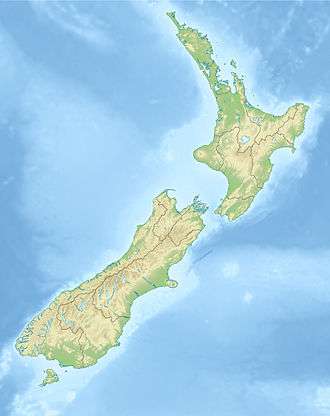Tahora Formation
The Tahora Formation is a Late Cretaceous geologic formation that outcrops in northeastern New Zealand near Gisborne.[2][3] It is Haumurian in age according to the New Zealand geologic time scale (mainly Campanian, but ranging from Santonian to lower Maastrichtian). It forms part of the Upper Cretaceous to Teurian (Danian) (lower Paleocene) Tinui Group. It unconformably overlies the Jurassic to Lower Cretaceous Urewera Group or the Upper Cretaceous Matawai Group. It is conformably overlain by the Haumurian to Teurian Whangai Formation. It consist of three members, the Maungataniwha Sandstone Member, the Mutuera Member and the Houpapa Member.[1] It is named for Tahora Station, south of Matawai in the Gisborne Region. The aptly named Maungataniwha (Māori for "mountain of monsters") Sandstone Member is known for its rich reptile fossil remains, first investigated by amateur palaeontologist Joan Wiffen.
| Tahora Formation Stratigraphic range: Santonian-Maastrichtian (Piripauan) ~85.8–66 Ma | |
|---|---|
| Type | Geological formation |
| Unit of | Tinui Group |
| Sub-units | Maungataniwha Sandstone Member, Mutuera Member, Houpapa Member |
| Underlies | Whangai Formation |
| Overlies | Urewera Group or Matawai Group |
| Thickness | ~500 m (1,600 ft)[1] |
| Lithology | |
| Primary | Sandstone, conglomerate |
| Other | Siltstone |
| Location | |
| Coordinates | 39.0°S 176.8°E |
| Approximate paleocoordinates | 59.4°S 168.8°W |
| Region | North Island |
| Country | |
| Extent | Gisborne |
| Type section | |
| Named for | Tahora Station |
 Tahora Formation (New Zealand) | |
Depositional environment
The whole of the Tinui Group is interpreted to be an upper Cretaceous transgressive sequence. The Maungataniwha Sandstone Member was deposited in a very shallow water to beach environment. The siltstones of the time-equivalent Mutuera Member are thought to have been deposited in a mid to outer shelf environment. The Houpapa Member is interpreted to be the fill of local channels cut into the underlying strata.[1]
Fossil content
Vertebrates
Indeterminate dinosaur remains have been recovered from the formation, including indeterminate theropod, titanosaur, nodosaurid, and hypsilophodont remains.[4] Other fossils found in the Tahora Formation are of the 40 feet (12 m) long mosasaur Moanasaurus and Rikkisaurus. The humerus of a pterosaur very similar to the Australian Mythunga has also been found. An ulna of an indeterminate pterosaur known has also been found in this formation. Other fossils include Onchopristis dunklei, Mauisaurus haasti and Tuarangisaurus keyesi.[5]
The theropod from the Tahora Formation would have been bipedal and likely carnivorous. Because of the lack of material, its exact taxonomic placement is uncertain, although its discoverer Joan Wiffen considered it possibly a megalosaurid, at the time a poorly defined group of unspecialized large carnivorous dinosaurs. The vertebra was described by Molnar (1981), and was considered an indeterminate theropod by Agnolin et al. (2010).[6][7]
Invertebrates
Invertebrates found in the formation include beetles,[8] ammonites, annelids, belemnites, bivalves, brachiopods, crinoids, crustaceans, gastropods, nautiloids and scaphopods.[3]
See also
- List of dinosaur-bearing rock formations
- Geology of the Raukumara Region
- Stratigraphy of New Zealand
- South Polar region of the Cretaceous
References
- Isaac M.J., Moore P.R. & Joass Y.J. (1991). "Tahora Formation: The basal facies of a Late Cretaceous transgressive sequence, northeastern New Zealand". New Zealand Journal of Geology and Geophysics. 34 (2): 227–236. doi:10.1080/00288306.1991.9514460.
- "Tahora Formation". New Zealand Stratigraphic Lexicon. GNS Science. Retrieved 25 May 2013.
- Vajda V. & Raine J.I. (2010). "A palynological investigation of plesiosaur-bearing rocks from the Upper Cretaceous Tahora Formation, Mangahouanga, New Zealand". Alcheringa. 34 (3): 359–374. doi:10.1080/03115518.2010.486642.
- Weishampel, et al. (2004). "Dinosaur distribution" Pp. 517-607. in Weishampel, David B.; Dodson, Peter; and Osmólska, Halszka (eds.): The Dinosauria, 2nd, Berkeley: University of California Press. 861 pp. ISBN 0-520-24209-2. " Pp. 517-607.
- Mangahouanga Stream at Fossilworks.org
- Molnar,R.E.1981.AdinosaurfromNewZealand.Pp.91–96in M.M.Cresswell&P.Vella(eds)GondwanaFive:Proceeding of the Fifth International Gondwanan Symposium. Wellington. A. A., Balkema, Rotterdam.
- Agnolin, F.L., Ezcurra, M.D., Pais, D.F. and Salisbury, S.W. (2010). "A reappraisal of the Cretaceous non-avian dinosaur faunas from Australia and New Zealand: Evidence for their Gondwanan affinities." Journal of Systematic Palaeontology, 8(2): 257-300
- GS 14182, Mangahouanga Stream (V19/f133) at Fossilworks.org